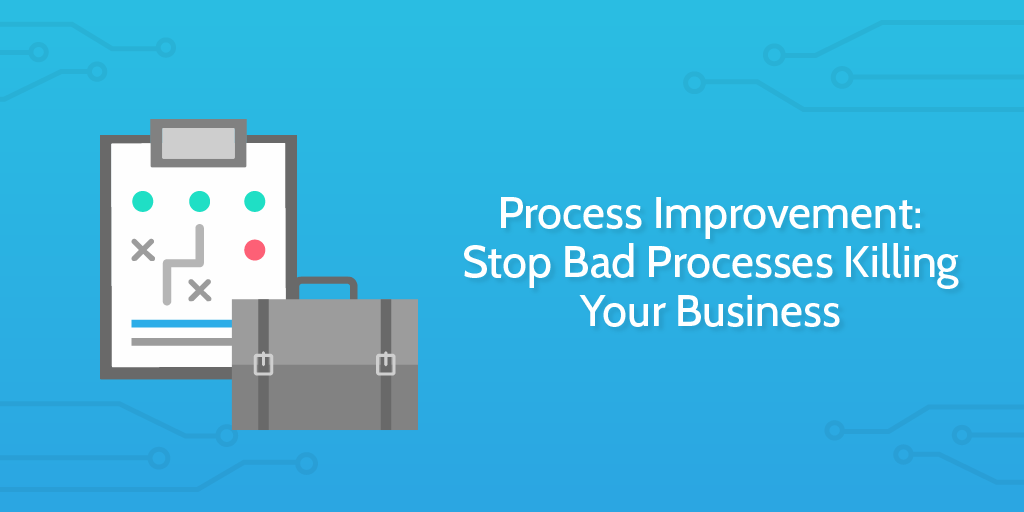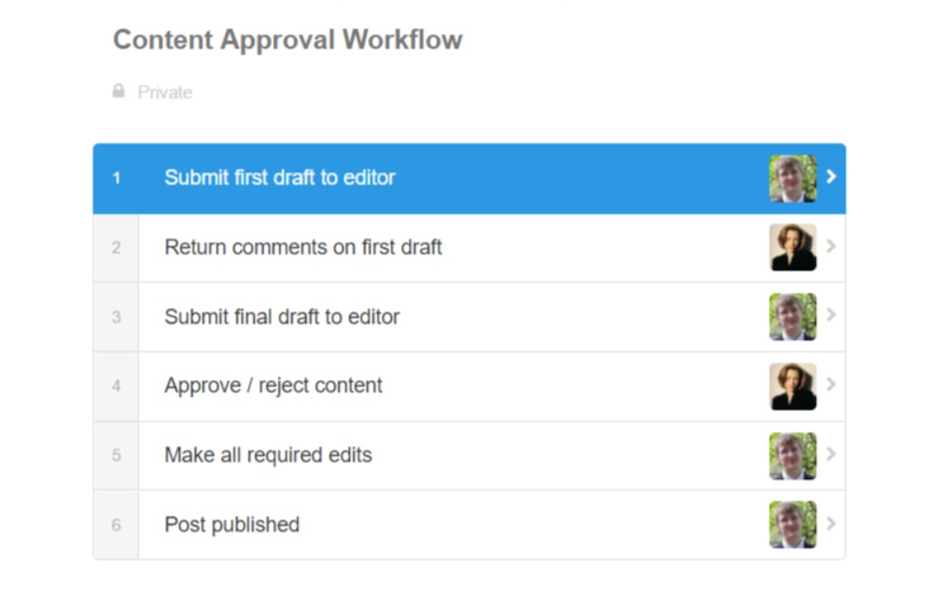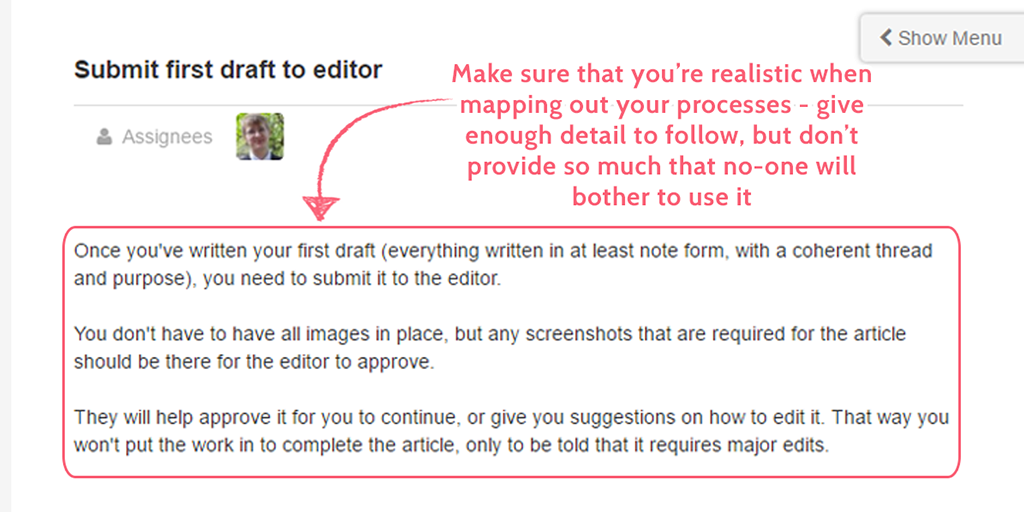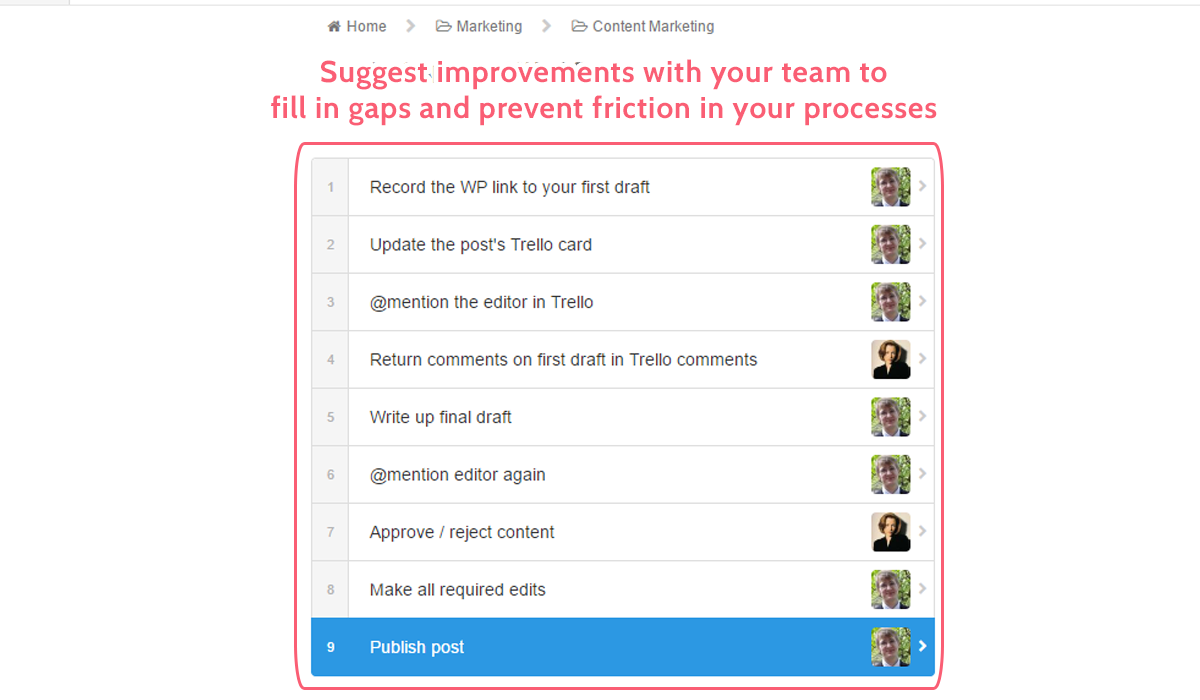
Last week we failed to meet a big deadline for the second time in a month. Vinay (Process Street‘s CEO) wasn’t impressed.
“How can you forget something so simple? What’s going wrong?”
Then came the kicker.
“What was your process?”
From missed deadlines to widespread cyber attacks, things go wrong in businesses all the time. The vast majority of problems, however, are caused by following bad processes. Processes might be vital to your business’ success, but unchecked they can just as easily cause you to fail.

The only way to change these weak links in your own business is to have a system of process improvement – a way of constantly improving the processes that power your business.
It might sound easy, but making sure you pick the right process, make the right improvements, and have those alterations stick can be a nightmare. Not only do you need to know how to do all of these things, but everyone who’ll be using the process has to be on board with it and understand why it’s necessary.
So, to help you polish your processes to a shine today I’ll be running through what process improvement is, and how to use it to boost efficiency, scale with consistency, and prevent disasters before they happen.
What is process improvement?
Process improvement is business-talk for “improving the way we do things”. Rather than solving problems as and when they appear, you’re proactively digging into your business’ processes and improving them.
Whether you’re looking to make your customers happier, increase your profit margins, or make sure that your business will produce consistent results at scale, you’ll achieve your goals by improving and optimizing your processes.
You don’t have to be a tech wizard either – all you have to do is select a process you want to improve, draft ways it could be improved, then test and deploy those changes. The specifics will change depending on your business model and goals, but every improvement method has the same result of weeding out friction and inefficiency at their roots.
In fact, all you need is our checklist template for optimizing a process.
I’m not saying it will be easy.
Process improvement contains many pitfalls and could involve radical ongoing changes to your business. It could even mean completely scrapping the way you currently do things and building new processes from the ground up.
The alternative, however, is letting your business succumb to inefficiency, eventually making both your processes and company obsolete.
Why you should care: boost efficiency, scale consistently, and prevent disasters
You have literally nothing to lose (and everything to gain) by improving your processes.
As long as your changes are thoroughly planned and tested before deployment, having an ongoing method of process improvement will increase your efficiency and overall success, no matter what your KPIs are. Whether you’re weeding out persistent pitfalls in your processes or refreshing your method with new software, there’s always something you can improve.
You’re not just boosting efficiency though – improving your processes allows you to effectively scale your business while staying consistent in your business model. Corners aren’t cut when new employees join because the exact process is there to follow at all times.
The time, money and manpower you save by improving your processes can, in turn, be directed towards more important tasks. In other words, every process you improve will benefit your entire business model.

But don’t take my word for it – take Taco Bell’s. By assessing and radically improving their processes, they went from being a regional success to the international giant we know today.
“Taco Bell has progressed from a $500 million regional company in 1982 to a $3 billion national company.” Hammer and Champy, Reengineering the Corporation, p.178-179
Taco Bell reached a point where they knew they had to drastically change to succeed and continue to scale. At the same time, they knew that maintaining a high standard was crucial to avoid backlash and potentially devastating errors (it’s bad press to give your customers food poisoning).
So, they sat down, took a look at their process for preparing food, then gutted and re-made the entire thing in their K-minus program. Rather than cooking everything themselves, they saved time and money by moving to buy pre-prepared ingredients. Their quality control also increased, as everything could be controlled from a central distribution center.
Admittedly, there is a slight proviso with this example; Taco Bell’s K-minus program is a more radical form of process improvement, which is called process reengineering.
Process improvement vs reengineering (with cake)
We’ve covered business process reengineering on the Process Street blog before, so I won’t go into too much detail. However, the main idea is that improvement takes a process you already have and tweaks it. Reengineering scraps the entire thing and starts fresh.
It might sound similar, but before you can improve your processes you need to know whether the framework is solid enough to warrant improving or reengineering. Now, I hate buzzwords, so let’s go for something easier to understand.
Imagine you’re baking a cake. You’ve made the cake before, but this time you want to make something better.
If your first cake was okay (or even good), you could tweak the recipe a little – maybe add a little more sugar, bake it for less time, and so on. In the same way, if your current processes work and produce the intended results, you probably just need to improve them a little to avoid re-inventing the wheel.
If, however, the first cake tasted like your garbage disposal, it’s best to scrap the old recipe and try a new one. You’re still making a cake, but your method will be radically different. Here you’re reengineering your process by trashing the old method entirely and building a new one. Harsh steps like this are best for when a process is entirely failing to produce the results you wanted or if the old process had multiple core faults which made the whole thing too unstable to use.

Again, if you’d like to know more, check out our previous post on business process reengineering and our free business process management guide. For now, let’s focus on process improvement.
How to improve processes (without the technical jargon)
It’s easy to get bogged down in technical jargon and the various schools of process improvement, but it shouldn’t be that hard to eliminate the problems in your business. That’s why I’ve summarized a basic process improvement method you can use to boost your business’ success.
Select the process to improve
To create business systems and process you first need to identify and select the process you’re going to improve. This should be your most important process or one where problems commonly occur.
For example, if you know that your customer satisfaction rating is low, you could overview various processes which contribute to that and select the worst performer. This could be your support process, your product’s user experience, or even your user onboarding flow.
Don’t take the process selection for granted either – selecting the correct process to improve is the difference between a high return from your efforts and nothing short of wasted time.
Let’s take our own content approval process. Right now, ours does the job of telling us who needs to check over a post, but there are plenty of chances for the process to fail.

Define the objective of the process
Once you have your process, you need to define what the intended outcome for it is. To do this (and for most process improvement steps going forwards) you need to meet with the team responsible for the process, as this will help you get a more rounded opinion of what it needs to be and how to go about achieving that.
This might seems inconsequential, but it will help you later on when assessing what sections of your current process need to be changed.
The objective of our content approval process is to produce high-quality content faster. The team should be able to rapidly assess any and all content in order to achieve that goal.
Map out the process
To know what to improve, you need to know how your process is currently carried out. This is also another reason why you need to meet with the team (or at least senior team members) responsible for carrying out the process, as they will have hands-on experience with it.

Remember, this shouldn’t be a game of mapping out your ideal process – you need to know what steps would be followed if the process was run right this second. Transparency at this stage is far more important than sugar-coating how your business is run, so keep drilling down until you know exactly what goes on.
Although utterly simplistic, our content approval process is already documented (as shown earlier). While very high level, this is the process we follow when approving content.
Analyze the process
You know what your process is, what it should be achieving, and what your team does at the minute. Now it’s time to link all of that together and analyze what’s causing the problem.

Whether a particular step is outdated, the chain of communication is lagging, or the process just plain isn’t followed, here is where you need to find out where the friction in your processes are and why you’re not hitting your targets. Again, remember to include the relevant team members in this talk, as they will be able to tell you how the process works in practice, and where the things tend to derail.
For our process, the main friction point was the lack of information in the process itself. Although the steps themselves were simple and assigned to the right people, the lack of instruction meant that drafts were being sent using various different apps, which in turn made it difficult to identify exactly when one had been put up for approval.
Suggest improvements as a group
Although you may need to do a little research, it’s now time to draft your process improvements. Typically (and again, with help from your group) you’ll have already identified what needs to change, but you’ll also probably need to spend some time doing a little research.
One great way you can do this is to find out how your competitors are solving the problem you have, and then looking into extra ways you can improve on what they’re doing. This could be as simple as removing some steps and simplifying the process, changing the tool that you’re using, or increasing accountability for a particular segment.

Test the improvements
I can’t over-stress how important it is to test the process improvements before you deploy them. Ideally, you’ll want to do so in as close to a live environment as possible, but at the very minimum you should consult your team to account for factors which can’t be replicated.
For example, if you’re improving your manufacturing process and can’t test your alterations without using a live environment, try limiting the batch size to limit potential damage, and make sure that before you run the test you’ve accounted for things such as delivery times and the chance of a machine breaking.
If the new process hits your expectations and consistently performs better than the old one, it’s time to move on to deploying your changes. If not, it’s back to the drawing board to see what you might have missed when either mapping out the process or suggesting improvements.
Deploy your changes
Now all that’s left to do is to deploy your changes. The key here is making sure that your process improvements are actually kept up by the people performing them – the greatest process in the world would be useless if not used correctly.

To do this you need to highlight to the team that will be following the process what changes have been made and (most importantly) why the changes are what they are, and why they were necessary. Again, this is a great reason to work with the team (or at least core members of it) when mapping, analyzing, and improving the process.
Working with the relevant teams like this effectively makes them co-authors of the new process – they know exactly what’s changed, why it’s changed, and what results they will get if they stick to those changes. Not only that, but they will be able to pass on that knowledge and drive to the rest of their team to help everyone stick to the new process.
Rinse and repeat
Although this is a fairly basic model, it’s also by far the easiest to use and repeat – any and every process you follow can be improved by following the steps above.
If you want to get a little more complex and tailor your process improvement method to your precise needs if you want to get more complicated with it, there are six main schools of process improvement to suit your specific business model and focus.
Six process improvement schools to suit your business model
Although we’ve already covered the various schools of thought for process innovation and improvement, here’s a quick recap of what the schools are.
- ISO 9001: More of a quality certification than an improvement method, which focuses on meeting customer and company needs
- JIT (Just In Time): Prioritizing efficiency over quality and reducing waste wherever possible
- Lean: Rapidly iterating with an aim to reduce waste and improve customer value
- Six Sigma: Another certification, this time to show that your results have less than 3.4 “errors” in every million
- Theory of Constraints: Repeatedly finding and reducing the biggest constraint in your business
- Visual Process Innovation: Defining and improving your existing processes (much like the basic steps laid out above) with a heavy emphasis on visually mapping the process to emphasize flaws and holes

As for when to use each to its full ability, let me run through them quickly.
ISO 9001
ISO 9001 is more of a certificate which you can apply for than an actual method of process improvement. However, if you improve your processes with the aim to get certified, the overall gist is that you’ll have to have a high standard of almost every aspect of your business, including waste management, efficiency, accuracy, and customer focus. You can find their criteria here.
JIT
JIT is good for keeping costs down, but implementing a framework which supports it can be costly, both to set up and to your initial results. Since JIT is so focused on reducing waste, implementing an inventory systems following that theory requires a lot of trial and error, and any miscalculation will usually be very costly.
Lean

Lean is very flexible, with its short iteration cycles being ideal for companies and products which need to adapt quickly. However, lean is difficult to implement correctly and performs badly when it’s strictly enforced. This quick iteration model (in worst case scenarios) can lead to normalized deviance, meaning it’s good to combine with a solid framework such as visual process innovation.
Six Sigma
Six Sigma is good for areas such as manufacturing, as it can reduce errors almost infinitely when dealing with processes which run on hard data and statistics. However, strictly enforcing it can stifle innovation and creativity, not to mention make your company a drag to work for (thus increasing employee turnover).
Theory of Constraints
The Theory of Constraints works wonders for reducing the impact of errors because you’re constantly searching for (and strengthening) the weakest link in your company. However, ToC can also be very difficult to implement because the range of tasks you’ll have to improve covers everything your business touches.
Visual Process Innovation
Finally, Visual Process Innovation is a good all-around method for providing a solid framework for your processes and documenting them effectively. This idea of creating a framework for your processes is also easy to combine with other schools of process improvement, such as lean
Use the best process improvement and documentation tool on the market
Documenting your processes is vital to process improvement – if you don’t know what process you’re following there’s no way you can tweak it to boost your success.
Unfortunately, Word documents are pretty awful for recording your processes. Every time you improve a process you’ll either need to overwrite the old document or create a new one, which takes up space and clutters your storage system (especially if you’re printing out your processes to use physical copies as checklists).
You need the best workflow management software on the market. You need Process Street.
With Process Street, you can easily create rich process templates that everyone can understand and follow. Our drag and drop editor lets you document processes in seconds, and we even have a library of premade example templates that you can use straight away.
Don’t believe that we’re the best business process management software available? Check out Process Street reviews and see for yourself.
To learn more, check out our help site or sign up for a free account today at www.process.st.
How do you check your own processes? Do you have any cautionary tales from your own experiences? I’d love to hear from you in the comments below.







 Workflows
Workflows Projects
Projects Data Sets
Data Sets Forms
Forms Pages
Pages Automations
Automations Analytics
Analytics Apps
Apps Integrations
Integrations
 Property management
Property management
 Human resources
Human resources
 Customer management
Customer management
 Information technology
Information technology





Ben Mulholland
Ben Mulholland is an Editor at Process Street, and winds down with a casual article or two on Mulholland Writing. Find him on Twitter here.